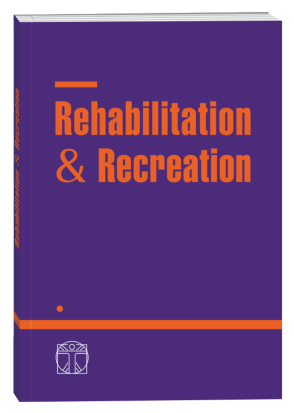IMPACT OF PHYSICAL THERAPY PROGRAM ON THE FUNCTIONAL STATUS OF WORKING-AGE PATIENTS WITH HIV AT THE AIDS STAGE
DOI:
https://doi.org/10.32782/2522-1795.2024.18.3.12Keywords:
HIV/AIDS, physical therapy, program, exercisesAbstract
Purpose – to investigate the effectiveness of a structured combined physical therapy (PT) program utilizing both anaerobic and aerobic exercises in altering the functional status of working-age patients with HIV at the AIDS stage. Materials and methods. The study included 24 patients with confirmed HIV infection at clinical stage IV, with 15 forming the control group. Patients were divided into two experimental groups based on body mass index (BMI) and CD4+ T-lymphocyte levels. Group I comprised 11 patients with BMI less than 18.5 and CD4+ T-lymphocytes ≤ 100 cells/μL, while Group II consisted of 13 patients with BMI between 18.5 and 24.9 and CD4+ T-lymphocytes above 150 cells/μL. The 12-week program included home exercises and three combined training sessions per week lasting 60 minutes each. Results. The program positively impacted BMI, Hobbs index, 6-minute walk test, respiratory rate, SpO2, hypoxia index, heart rate, and diastolic blood pressure. Improvement was also observed in fatigue levels and quality of life indicators. Biochemical analysis showed an increase in creatinine levels, while no statistically significant changes were observed in other parameters. Conclusion. Based on the results obtained, it can be concluded that the 12-week combined PT program has a positive effect on the functional status, fatigue levels, and quality of life in working-age patients with HIV at the AIDS stage. No negative impact on the course of HIV infection or the health status of the patients included in the study was observed. Further research is recommended to explore the feasibility of increasing the intensity and training volume, duration, and dosage of physical exercises.
References
Agbonlahor E.I. Effects of 6-weeks Aerobic and Resistance Training Programmes on Hematological Profile of HIV-Seropositive Female. International Journal of Aging Health and Movement, 2020. 2(2), 28–34.
American College of Sports Medicine. Acsm’s guidelines for exercise testing and prescription (Eleventh). Wolters Kluwer. 2022.
Aweto H.A., Aiyegbusi A.I., Ugonabo A.J., & Adeyemo T.A. Effects of Aerobic Exercise on the Pulmonary Functions, Respiratory Symptoms and Psychological Status of People Living With HIV. Journal of research in health sciences, 2016. 16(1), 17–21.
Bhochhibhoya A., Harrison S., Yonce S., Friedman D.B., Ghimire P.S., & Li X. A systematic review of psychosocial interventions for older adults living with HIV. AIDS care, 2021. 33(8), 971–982. https://doi.org/10.1080/09540121.2020.1856319.
Ceccarelli G., Pinacchio C., Santinelli L., Adami P.E., Borrazzo C., Cavallari E.N., ... & d’Ettorre G. Physical activity and HIV: effects on fitness status, metabolism, inflammation and immune-activation. AIDS and Behavior, 2020. 24, 1042–1050.
deBoer H., Andrews M., Cudd S., Leung E. et al. Where and how does physical therapy fit? Integrating physical therapy into interprofessional HIV care. Disability and Rehabilitation. 2019. 41(15), 1768–1777, DOI: 10.1080/09638288.2018.1448469.
Kang D.W., Fairey A.S., Boulé N.G., Field C.J., Wharton S.A., & Courneya K.S. Effects of exercise on cardiorespiratory fitness and biochemical progression in men with localized prostate cancer under active surveillance: the ERASE randomized clinical trial. JAMA oncology, 2021. 7(10), 1487–1495.
Nunhes P.M., Marchini K.B., Souza D.C.D., Domingues W.J.R., Trindade M.C.D.C., Deminice R., ... & Avelar A. Effect of a single resistance exercise session on inflammatory
markers and oxidative stress in women living with HIV. Journal of Physical Education, 2023. 34, e3420.
O’Brien K.K., Tynan A.M., Nixon S.A., Glazier R.H. Effectiveness of aerobic exercise for adults living with HIV: systematic review and meta-analysis using the Cochrane Collaboration protocol. BMC Infect Dis. 2016; 16:182. doi: 10.1186/s12879-016-1478-2.
Oliveira V.H., Rosa F.T., Santos J.C., Wiechmann S.L., Narciso A.M., Franzoi de Moraes S.M., ... & Deminice R. Effects of a combined exercise training program on health indicators and quality of life of people living with HIV: a randomized clinical trial. AIDS and Behavior, 2020. 24, 1531–1541.
Ozemek C., Erlandson K.M., & Jankowski C.M. Physical activity and exercise to improve cardiovascular health for adults living with HIV. Progress in cardiovascular diseases, 2020. 63(2), 178–183.
Shittu A., Mohammed J., & Badirudeen A. Effect of aerobic exercise on functional capacity and health status of individuals living with HIV/AIDS in Kano, Nigeria: pilot study. Physiotherapy, 2020. 107, e161–e162.
Soares V.L., Soares W.F., Zanetti H.R., Neves F.F., Silva-Vergara M.L., & Mendes E.L. Daily Undulating Periodization Is More Effective Than Nonperiodized Training on Maximal Strength, Aerobic Capacity, and TCD4+ Cell Count in People Living With HIV. Journal of strength and conditioning research, 2022. 36(6), 1738–1748. https://doi.org/10.1519/JSC.0000000000003675.
Soares W.F., Soares V.L., Zanetti H.R., Neves F.F., Silva-Vergara M.L., & Mendes E.L. Effects of Two Different Exercise Training Programs Periodization on Anthropometric and Functional Parameters in People Living with HIV: A Randomized Clinical Trial. International journal of exercise science, 2022. 15(3), 733–746.
Wu J., Lai T., Han H., Liu J., Wang S., & Lyu J. Global, regional and national disabilityadjusted life years due to HIV from 1990 to 2019: findings from the Global Burden of Disease Study 2019. Tropical Medicine & International Health, 2021. 26(6), 610–620.
Downloads
Published
How to Cite
Issue
Section
License
Copyright (c) 2024 А. Я. Орфін, М. А. Мазепа, О.А. Бас

This work is licensed under a Creative Commons Attribution-NonCommercial-NoDerivatives 4.0 International License.











